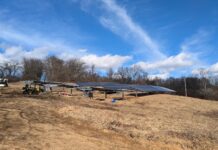
If you enjoy gardening for wildlife, or even just watching animals visit your green space, it might be time to consider upgrading your garden or backyard green space to a Certified Wildlife Habitat via National Wildlife Federation.
Certified Wildlife Habitats come in all shapes and sizes. They can be squeezed into existing landscapes in the form of balcony green spaces, container gardens, school and office landscaping, roadside pollinator areas and wildflower corridors between agricultural fields. Or they can be worked into extensive land management or conservation plans, spanning entire backyards and taking up acres of space.
No matter the size, creating a Certified Wildlife Habitat can make a lasting impact on your local ecosystem, helping important pollinators and at-risk species survive and thrive.
Why do we need wildlife habitats?
A number of factors are contributing to the loss of important pollinators and other at-risk species. For many of them, habitat loss is central to their battle for survival. Every garden and green space that provides food, water, cover and places to raise young helps replenish resources for a variety of bees, butterflies, birds, amphibians and mammals.

How to certify your green space
A Certified Wildlife Habitat is required to have at least two food sources, one water source, two areas that provide cover and two areas that allow wildlife to raise young. As the caretaker of this habitat, you’ll be required to implement a couple of different types of sustainable management practices. And last but not least, National Wildlife Federation recommends planting a minimum of 50% to 70% native plants that provide multi-season bloom in your wildlife habitat.
Food. In order to earn certification, your wildlife habitat should provide a minimum of three of the following types of food:
- Native plants
- Berries and seeds
- Nectar
- Foliage and twigs
- Fruits
- Sap
- Pollen
- Suet
- Bird feeder
- Squirrel feeder
- Hummingbird feeder
- Host plants for caterpillars
Water. In order to earn certification, your wildlife habitat should provide one of the following sources of clean water, so wildlife can drink and bathe:
- Birdbath
- Lake
- Stream
- Seasonal pool
- Ocean
- Spring
- River
- Butterfly puddling area
- Rain garden
- Water garden or pond
Cover. In order to earn certification, your wildlife habitat should provide at least two places wildlife can seek shelter from weather and predators:
- Wooded area
- Bramble patch
- Ground cover
- Rockpile or rock wall
- Cave
- Roosting box
- Evergreens
- Brush pile or log pile
- Burrow
- Meadow or prairie
- Dense shrubs, thickets
- Water garden or pond
Places to raise young. In order to earn certification, your wildlife habitat should provide at least two places wildlife can engage in courtship behavior, mate and then bear and raise their young:
- Mature trees
- Meadow or prairie
- Nesting boxes
- Wetland
- Cave
- Burrow
- Dead trees or snags
- Dense shrubs, thickets
- Water garden or pond
- Host plants for caterpillars
Once your green space features all of the elements needed to become a Certified Wildlife Habitat, you’ll need to implement some sustainability practices to maintain it and earn certification.
National Wildlife Federation requires applicants to use at least one practice from two of the three categories below to manage their wildlife habitat.
Soil and water conservation
- Install a riparian buffer.
- Capture rainwater from your roof. You can accomplish this by installing a rain barrel or rain garden.
- Design your landscape to reduce or eliminate the need for irrigation.
- Use a drip or soaker hose for irrigation.
- Limit water use.
- Reduce erosion.
- Use mulch.
- Plant a rain garden.
Controlling exotic species
- Practice integrated pest management.
- Regularly remove non-native plants and animals from your habitat.
- Plant native plants.
- Reduce lawn areas.
Organic practices
- Don’t use chemical pesticides.
- Don’t use chemical fertilizers.
- Use compost to improve your soil and reduce waste.
Becoming a National Wildlife Federation Certified Wildlife Habitat
After you’ve gone through this checklist to make sure your wildlife space meets all the criteria to become certified, you can apply at https://www.nwf.org/certify.












